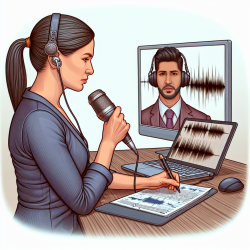In the field of speech-language pathology, data-driven decisions are paramount to achieving the best outcomes for children. One area that demands further exploration is the impact of auditory neuropathy spectrum disorder (ANSD) on vocal characteristics. The recent study titled Acoustical and Perceptual Voice Characteristics in Adults With Early- and Late-Onset Auditory Neuropathy Spectrum Disorder offers invaluable insights that can help practitioners refine their approaches and encourage further research.
Key Findings and Their Implications
This pioneering study analyzed the vocal characteristics of 31 participants diagnosed with ANSD, divided into early-onset and late-onset groups. The researchers utilized both acoustical and perceptual evaluations to uncover significant differences between these groups. Here are the key findings:
- Increased Fundamental Frequencies: The study revealed significantly higher fundamental frequencies (F0) in early-onset participants compared to their late-onset counterparts. This suggests that early-onset ANSD may lead to greater laryngeal muscular tension and impaired internal auditory feedback.
- Formant Frequencies: The second and third formant frequencies (F2 and F3) of the vowel /i/ were notably higher in the late-onset group. This indicates that late-onset ANSD patients may have better high-frequency perception and production capabilities.
- Perceptual Evaluations: Perceptual ratings indicated that early-onset participants exhibited greater roughness, breathiness, and strain in their voices compared to late-onset participants. This aligns with the notion that early-onset ANSD can severely impact auditory feedback and vocal control.
Implementing Research Outcomes
Practitioners can leverage these findings to enhance their therapeutic approaches for children with ANSD. Here are some practical steps:
- Customized Therapy Plans: Develop individualized therapy plans that consider the onset of ANSD. Early-onset patients may benefit from exercises aimed at reducing laryngeal tension and improving pitch control.
- Acoustic Analysis Tools: Utilize acoustic analysis tools like Praat software to monitor vocal characteristics over time. This can help in assessing the effectiveness of therapy and making necessary adjustments.
- Perceptual Evaluation: Incorporate perceptual evaluations using standardized scales such as the Consensus Auditory Perceptual Evaluation of Voice (CAPE-V) to gain a comprehensive understanding of vocal quality and its progression.
Encouraging Further Research
The study opens the door for further research into the nuanced differences between early- and late-onset ANSD. Future studies could explore:
- Longitudinal Studies: Conduct long-term studies to track changes in vocal characteristics and their correlation with therapy outcomes.
- Advanced Acoustic Measures: Utilize advanced acoustic measures such as cepstral peak prominence and dysphonia severity index to provide a more detailed analysis of vocal quality.
- Broader Population Studies: Expand the research to include a more diverse population, considering factors such as age, gender, and language background.
By integrating these research outcomes into practice and encouraging further investigation, practitioners can significantly improve the therapeutic outcomes for children with ANSD.
To read the original research paper, please follow this link: Acoustical and Perceptual Voice Characteristics in Adults With Early- and Late-Onset Auditory Neuropathy Spectrum Disorder










